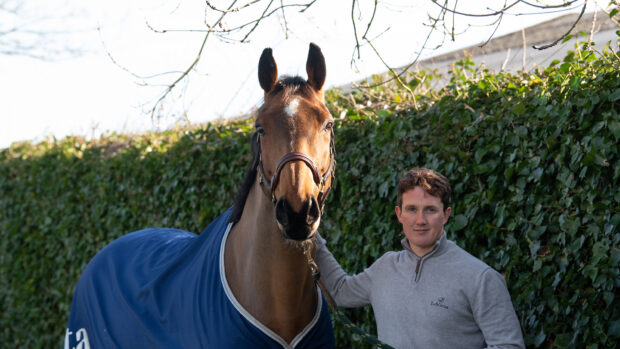Walking the course
- You should walk the exact track you intend to ride.
- Watch out for “traps” built by coursebuilders.
- Don’t just learn which order the jumps go in, but check on the striding between combinations and obstacles set at related distances.
- Check whether there is any danger of the sun getting in your eyes or if it reflects strongly off bright paintwork.
- Take note of any gradients and the state of the going.
- Look for any likely short cuts which could be taken in the jump off.
- Concentrate on the job in hand and walk the course by yourself or with your trainer to avoid distraction.
- Walk the course several times,if possible, to make sure you know it well.
If you are putting your number down on a blackboard, try to go about half to three quarters of the way down the list, unless you are riding more than one horse. This will give you the opportunity to watch the first few competitors tackle the course so you can see how it is riding.
Warming up
- Loosen your horse up properly on the flat before popping over the practice fence a couple of times.
- Don¨t overdo it in the practice ring – if you keep jumping the practice fences your horse may lose his enthusiasm.
In the ring
- Keep your horse on the move in an active walk, riding turns and circles, otherwise your horse is likelyto switch off.
- Try to finish warming up in time to coincide with your number being called.
- When you enter the ring, send your horse forward into trot and then canter, establishing your balance, speed and rhythm.
- If it takes the judge a few moments to ring the bell, calmly canter a few circles close to the first fence.
- Once the bell goes take a few seconds to focus yourself and present your horse correctly to the first fence.
- Setyour horse up so you approach the first fence leading with the corresponding leg for any turns.
- Think ahead and keep your eye on each jump you approach so that you don¨t misjudge your line.
- Treat complicated, and simpler looking fences with equal respect.
- Don’t become complacent before the round is over.
- Remember to pass through both the start and finish boards.
Against the clock
- Once you have completed your round and gone clear, study the jump off plan carefully and make sure you know your way.
- If you and your horse are fairly novice, it is worth aiming for a slow and steady clear to give you both confidence.
- You will have to cut a few corners to achieve a fast time. Think about where seconds can be saved by making a tight turn and where you will need to ask your horse to travel on.
- If you are drawn to go fairly late, see how other competitors tackle the course andmake sure your horse remains ready.
- Try not to get all fired up as this may lead to mistakes.
- Remember, a slower approach, with a short, bouncy stride will mean you can turn your horse quickly and neatly on landing.
Common problems
- Nerves can affect some competitors riding adversely. This can in turn upset the horse, which further affects the rider.
- To give you a bit of confidence and put your nerves to rest you may find it useful to do a small clear round class as part of your warm up.
- If your horse rattles a jump, don¨t look back – there¨s nothing you can do if it falls.
- Finally, aim to learn from your errors and try not to repeat them.


